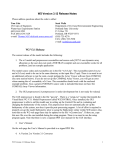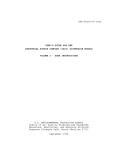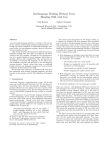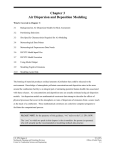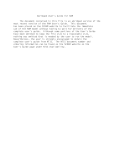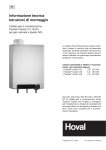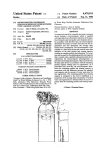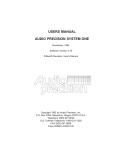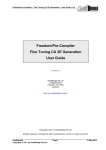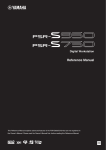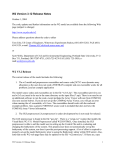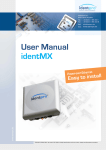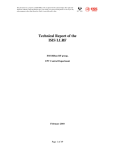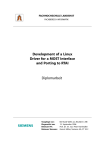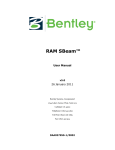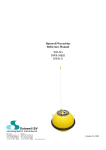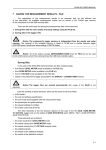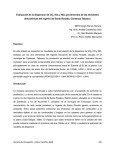Download AIR QUALITY IMPACT ANALYSIS
Transcript
Santa Barbara County Air Pollution Control District MODELING GUIDELINES FOR AIR QUALITY IMPACT ANALYSIS Santa Barbara County Air Pollution Control District MODELING GUIDELINES FOR AIR QUALITY IMPACT ANALYSIS June, 1996 MODELING GUIDELINES FOR AIR QUALITY IMPACT ANALYSIS SANTA BARBARA COUNTY AIR POLLUTION CONTROL DISTRICT 26 Castilian Drive, B-23 Goleta, California 93117 (805) 961-8800 June, 1996 TABLE OF CONTENTS Abbreviations and Acronyms iii OVERVIEW 1 I. A. B. C. D. E. Introduction General Procedures Source Parameters Models Source of Models Submittals to the District 2 2 2 3 4 6 II. A. B. C. Screening Analysis General Information SCREEN Averaging Time Conversions 6 6 6 8 III. Modeling Point Sources with ISCST A. General Information B. Point Sources in Simple, Intermediate, or Complex Terrain C. Building Downwash Considerations 9 10 IV. A. B. C. D. E. Modeling Onshore Point Sources with RTDM General Information Model Inputs RTDM Options Running RTDM Postprocessor Analysis 12 13 13 14 17 18 V. A. B. C. D. E. Modeling Onshore Non-Point Sources with ISCST General Information ISCST Options ISCST Modeling of Volume, Line and Area Source Types Scheduling and Averaging Period Considerations Meteorology 19 19 20 20 25 27 VI. Modeling Offshore and Associated Coastal Source Emissions General Information OCD Model Input Requirements Point Source Description Information Meteorology Shoreline Geometry 27 27 29 29 32 39 A. B. C. D. E. 9 9 VII. Fumigation Modeling 39 VIII. Background Air Quality/Ozone-Limiting Method A. Use of Background Air Quality for Pollutants Other Than NO 40 40 1 B. Use of Background Air Quality for NO 41 IX. A. B. Receptor Grid Spacing General Requirements Model Specific Requirements 42 42 42 X. Modeling of Emission Reduction Credits (Offsets) 44 XI. References 45 LIST OF TABLES TABLE 1. Generic Project Scenarios and Required Modeling Analyses 5 TABLE 2. Meteorological Data Format 12 TABLE 3. Main Model Options for OCD Simulations 30 TABLE 4. Typical Surface Roughness Lengths for Various Ground Covers TABLE 5. Additional Meteorological Data Options for OCD Simulations 31 TABLE 6. Reasonable Worst-Case Meteorological Data Set for OCD Simulations 38 TABLE 7. Factors to Convert One-Hour Modeled Concentrations to Longer Averaging Periods 39 2 37 Abbreviations and Acronyms AQIA Air Quality Impact Analysis ATC Authority To Construct BPI Bits per inch CAAQS California Ambient Air Quality Standard CARB California Air Resources Board COMPLEX-I Complex Terrain Model for Point Sources District Santa Barbara County Air Pollution Control District EPA Environmental Protection Agency g/s Grams per Second GEP Good Engineering Practice ISCST Industrial Source Complex -- Short Term Model 0 K Degrees Kelvin m Meters m/s Meters Per Second MMS Minerals Management Service MPTER Multiple Point Guassian Dispersion Algorithm with Optional Terrain Adjustment NTIS National Technical Information Service NSR New Source Review OCD Offshore and Coastal Dispersion Model OCS Outer Continental Shelf ppm Parts Per Million PTFUM A Single Source Fumigation Model PSD Prevention of Significant Deterioration ROW Right of Way RTDM Rough Terrain Dispersion Model SCREEN Screening Procedures for Stationary Sources UNAMAP User's Network for Applied Modeling of Air Pollution 3 AQIAGDLS.WP5 JUNE, 1996 Rev #2 OVERVIEW This document presents the current Santa Barbara County Air Pollution Control District (District) guidance on the use of air dispersion modeling to assess the air quality impacts of stationary sources. The document represents an update and revision to the October 20, 1987 version of Chapter 6 (Air Quality Impact Analysis) from the Authority to Construct (ATC) Permit Processing Manual. In addition to the technical revisions, the guidelines have been brought under a separate, stand-alone, cover. An Air Quality Impact Analysis (AQIA) is required when applicable emissions thresholds specified in District rules are exceeded. These emission trigger levels are specified in District Rules and Regulations (i.e., New Source Review) for both attainment and nonattainment pollutants. Depending upon the pollutants to be assessed, an AQIA may be required to evaluate compliance with ambient air quality standards, increment consumption, or both. For the evaluation of ambient air quality standards, existing California and National standards are the established criteria. These analyses must consider the background air quality levels in conjunction with project emissions. An increment consumption analysis is only applicable to attainment pollutants for which allowable increment levels have been established to limit the amount of air quality degradation in an attainment area. All increment consuming sources must be included in an increment analysis. Air dispersion models generally simulate two types of pollutants, inert and reactive. Inert pollutants are commonly modeled using Gaussian assumptions while reactive (photochemical) pollutants are simulated with Lagrangian or Eulerian schemes. This document only addresses inert pollutant modeling. Guidance on reactive pollutant modeling can be obtained from the California Air Resources Board (CARB) document entitled "Technical Guidance Document: Photochemical Modeling (CARB, 1990)." Section I presents an introduction to some general aspects of the Districts modeling requirements including discussions on the procedures to be followed while performing an AQIA, what models are to be used in the analysis, where to obtain the models, and what is required in a submittal to the District for review and approval. Sections II through VI discuss specific model requirements for SCREEN, ISCST, RTDM, and OCD. Section VII, Fumigation; Section VIII outlines the proper use of background air quality values and the ozone-limiting method. Sections VIX and X discuss the proper placement of receptors and the use of offsets in the AQIA, respectively. References are provided in Section XI. 1 AQIAGDLS.WP5 JUNE, 1996 Rev #2 I. Introduction A. General Procedures An inert pollutant modeling assessment will normally involve a two-phased approach. The first phase of the assessment is to apply a simple screening procedure to determine if either: - The source clearly poses no air quality problem, or - The potential for an air quality problem exists. If the screening procedures indicate that there may be a potential air quality problem, a refined analysis must be undertaken. Both screening and refined analyses are discussed in this document. All emissions from the stationary source being analyzed are to be included in the AQIA. This includes facilities in the Outer Continental Shelf (OCS) and outside of Santa Barbara County which have the potential to impact Santa Barbara County air quality, and all facilities within the jurisdiction of the District. In addition, the AQIA may be expanded if project conditions placed on the applicant by other regulatory agencies direct that other scenarios be examined by the District. Examples of additional issues for which analysis may be required include, but may not be limited to: - Air quality impacts from consolidated facilities. - Cumulative air quality impacts from proposed project and all reasonably foreseeable projects. - Air quality impacts from construction emissions. - Future specific throughput rates or levels of production not applied for by the applicant. Air quality modeling is extremely source-specific. Complex source configurations may require extensive modeling procedures which would not be needed to assess a simple source. Because of this, the District recommends that a modeling protocol be submitted for all projects prior to executing the models. The protocol must contain all relevant modeling information including the specific model to be executed, program control data, source parameters, receptor data, and meteorological data. All procedures must be clearly described so that District staff can approve the methodology being proposed. This protocol process saves both time and money if used correctly. B. Source Parameters 2 AQIAGDLS.WP5 JUNE, 1996 Rev #2 For each source of pollutants modeled, the following inputs are required: - source coordinates (UTM) - pollutant emission rate (g/s) - stack height (m) - stack gas exit temperature (0K) - stack gas exit velocity (m/s) - source elevation (m) Emission rates used as input to the models for a proposed source must be the applicable emission increases from the stationary source. All emission increases from the source which have occurred or will occur after the preconstruction monitoring data are collected must be included. Additionally, emissions from other permitted sources which were not operating at permitted capacity at the time of preconstruction monitoring must be included in the modeling. Maximum hourly emission rates are to be used for modeling averaging periods less than or equal to 24 hours. Annual average emission rates are to be used for annual average concentration calculations. All of these parameters must be reviewed by District engineering staff prior to executing the model. C. Models For inert pollutant modeling, the models which are to be implemented are as follows: SCREEN: For all inert pollutant screening analyses. ISCST: For modeling inert pollutant impacts from all point sources which impact terrain with elevation less than the height of the lowest stack height. ISCST must also be used to model inert pollutant impacts from onshore non-point emission sources (e.g., area, volume, and line sources). RTDM: For modeling inert pollutant impacts from all onshore point sources which impact terrain with elevation equal to or greater than the height of the lowest stack height. 3 AQIAGDLS.WP5 JUNE, 1996 Rev #2 OCE: For modeling inert pollutant impacts from offshore sources and coastal point sources (up to 1 km from shoreline) associated with offshore sources of emissions. Table 1 provides some generic project scenarios and the associated modeling requirements. Screening analyses can be performed with SCREEN. For refined analyses, onshore point sources require the use of either ISCST or RTDM (dependent upon terrain). An exception to this requirement occurs if the onshore point source is physically linked to an offshore source (e.g., a processing plant onshore supplied by an offshore platform). Depending on the particular circumstances, OCD may be used for both onshore and offshore sources. It must be noted that the onshore source in question must be within one kilometer of the shoreline to be modeled with OCD. All onshore construction activities will be modeled with ISCST and summed with all concurrent point source emissions. In addition, fumigation modeling will be executed for all pollutant sources except onshore construction activities. For onshore sources, ISCST will automatically sum the hourly receptor concentrations from different source types in the same model run. For cases in which two different models are used (e.g., OCD for offshore point source, and ISCST for onshore area source), it may be necessary to use a post-processing routine to sum together pollutant concentrations for determining the total air quality impact at receptors. D. Source of Models ISCST, SCREEN, OCD, and RTDM are available from the National Technical Information Service (NTIS). ISCST is part of a library of air quality simulation models titled "User's Network for Applied Models of Air Pollution - Version 6" (UNAMAP 6) (USEPA, 1986). All these models can be directly downloaded from the EPA, Office of Air Quality Planning and Standards (OAQPS) Technology Transfer Network (TTN) electronic bulletin board. The telephone number to call to access the OAQPS TTN is 919-541-5742. When obtaining an air quality model from somewhere other than the District, it is imperative that the model be the most up-to-date version available. Please consult with District staff to assure that the correct version is being used. 4 AQIAGDLS.WP5 JUNE, 1996 Rev #2 TABLE 1. Generic Project Scenarios and Required Modeling Analyses SCENARIO SCREEN ISCST RTDM OCD yes no no no - Point Sources in Simple Terrain no yes no no - Building Downwash Analysis no yes no no - Area/Volume/Line Sources no yes no no no yes yes* no no no** no** yes Preliminary Screening Analysis Refined Onshore Analysis: (construction and fugitives) - Point Sources in Complex Terrain Refined Offshore Analysis: - All Sources * ** Alternative model Complex projects with both onshore and offshore components may have to perform multiple modeling analysis 5 AQIAGDLS.WP5 JUNE, 1996 Rev #2 E. Submittals to the District Upon completion of the model runs, the applicant must provide the District on hard-copy and magnetic media (IBM compatible 3.5" high density diskettes) all material leading to and including the final output(s). This would include, but not be limited to, all input files, control files, output files, pre- and post-processor programs and their input, output and control files, and all models used. In short, supply all the information needed to duplicate the work submitted by the applicant. II. Screening Analysis A. General Information A screening analysis is intended to provide a conservative estimate of the impacts from stationary sources to ascertain whether the potential for an air quality problem exists. The procedures are intended to be quick and inexpensive. Because of these factors, there are many limitations to the application of screening procedures. Highly complex projects (e.g., multiple stacks, differing source types) can not be assessed using these simple procedures. If a screening procedure reveals the potential for an air quality problem, a refined analysis must be undertaken. 1. Applicable Source Types The screening techniques presented in this section apply primarily to continuous, steady-state releases which are neutral or positively buoyant. For screening purposes, intermittent sources should be considered continuous and modeled using the worst-case 1-hour emission rate. The following list summarizes the source types for which screening is applicable: - onshore point sources in simple or complex terrain - onshore point sources with or without building downwash - onshore area and volume sources The procedures in the SCREEN model can estimate concentrations for each of the above source types. The PTPLU model can only be used to assess point sources without downwash in simple terrain. These models are discussed further below. B. SCREEN 1. Model Description The SCREEN model consists of several simple screening techniques 6 AQIAGDLS.WP5 JUNE, 1996 Rev #2 written into FORTRAN code. The techniques are used to calculate short-term concentrations for single sources. The model is interactive and is relatively user-friendly. 2. Options SCREEN can be used to assess air quality impacts from each of the scenarios listed above. All required data (including units) and available options are summarized below. a. Source parameters - Stacks - pollutant emission rate (g/s) stack height (m) stack inside diameter (m) stack gas exit velocity (m/S) stack gas exit temperature (0K) ambient air temperature (0K) -- use 290 b. Source parameters - Area Sources - emission rate (g/s) release height (m) length of side (m) c. Building downwash - building height (m) minimum horizontal building width (m) maximum horizontal building width (m) d. Complex terrain - terrain height (m) distance to terrain (m) e. Meteorology - full meteorology input single stability class input single stability class and wind speed urban or rural (1 or 2) f. Receptors - discrete distance (m) minimum distance (m) maximum distance (m) flagpole height (m) 3. Discussion 7 AQIAGDLS.WP5 JUNE, 1996 Rev #2 It is very important to examine both the geographical location and the project components before implementing these procedures. If the project being modeled has a combination of different source types (e.g., multiple sources), several runs should be executed and the impacts summed. For cases where there are differing technical considerations (e.g., building downwash versus complex terrain), both issues should be assessed with the highest results used. It may be necessary to run SCREEN several times to account for all these different scenarios. The building downwash option should be selected if there is a building within a distance of '5L' (where L is the lesser of building height or maximum projected building width) from the source. Input the building parameters accordingly (i.e., building height, length, and width, in meters). In case of more than one nearby buildings within a distance of '5L', select the building with the highest GEP stack height to calculate the building downwash effects. The GEP stack height (Hg) is calculated as follows: where, Hg = H + (1. 5 * L) H = building height in meters, and L = lesser of building height or maximum building width in meters. For a scenario with complex terrain and building downwash, first run SCREEN using the complex terrain option. Then, independently, run SCREEN using the simple terrain option with building downwash and setting receptor elevations at the stack top level. The highest value from the two runs should be selected as the maximum ambient concentration for screening purposes. In general, the full meteorology option should be run. However, if a source operates only certain hours during a day, it may be more appropriate to set specific stability and wind conditions. For receptors, the automated distance array option should generally be selected. The shortest distance from the source to its property boundary should be input as the minimum receptor distance, but in no case should the minimum distance be less than 100 m. The maximum distance should be selected such that the maximum impact has been covered for the source of interest. The model will calculate the distance to maximum impact within the distance range input. C. Averaging Time Conversions The screening procedure outlined in this section will estimate 8 AQIAGDLS.WP5 JUNE, 1996 Rev #2 both 1-hour and 24-hour concentrations. For some pollutants there are 3-hour, 8-hour and annual average standards. The applicable conversion factors to be used are summarized below. a. Simple Terrain Modeling Result Desired Averaging Time 1-Hour 3-Hour 0.90 1-Hour 8-Hour 0.70 1-Hour 24-hour 0.40 1-Hour Annual Avg. 0.10 b. Complex Terrain Modeling Result Desired Averaging Time 24-Hour III. Conversion Factor 1-Hour 24-Hour A. Conversion Factor 4.0 Annual Avg. 0.4 Modeling Point Sources with ISCST General Information 1. Model Description The Industrial Source Complex (ISC) model was designed to assess the air quality impacts from a wide variety of sources associated with an industrial source complex. In addition to modeling multiple point sources, ISC can simulate the dispersion from several types of non-point sources such as area, volume and line sources. There are both short- and long-term versions of the ISC model. The short-term version uses hourly meteorological data and is the version required by the District. ISCST is an EPA guideline model and is part of UNAMAP 6. Please refer to the USEPA user's manual when performing modeling analysis. 2. Terrain Applicability This section discusses the use of the ISCST model to assess point sources in simple, intermediate, or complex terrain. If the terrain height is less than or equal to the physical release height of a source, then that terrain is defined as simple terrain. If the terrain height is below the plume height but exceeds the physical release height, then that terrain is defined as intermediate terrain for that hour and source. For 9 AQIAGDLS.WP5 JUNE, 1996 Rev #2 intermediate terrain receptors, ISCST calculates concentrations from both simple terrain algorithm and the complex terrain algorithm and selects the higher of the two concentrations for that hour and that source. If the terrain height is equal or exceeds the plume height, then that terrain is defined as COMPLEX terrain for that hour and that source. For a complex terrain receptor, ISCST calculates concentrations based on the complex terrain screening algorithm only. B. Point Sources in Simple, Intermediate, or Complex Terrain This section discusses the values to be specified for each control option used by ISCST (the specifications are for ISCST version 93250, the most up-to-date version at the time these guidelines were published. 1. C. ISCST Control Option Specifications: Keyword Parameter MODELOPT CONC RURAL or URBAN GRDRIS NOBID NOCALM AVERTIME POLLUTID HALFLIFE DECAYCOEF TERRHGTS FLAGPOLE EVENTFIL SAVEFILE INITFILE MULTYEAR ERRORFIL 1 3 8 24 PERIOD SO2, NOX, CO, PM10, TSP or OTHER (Do not use) (Do not use) FLAT or ELEV (Do not use) (Do note use) (Do not use) (Do not use) (Do not use) (optional) Building Downwash Considerations 1. Downwash Assessment The entrainment of a plume in the wake of a building can result in the downwash of the plume to the ground. This effect can increase the maximum groundlevel concentration downwind of the source. Because of this, each source must be evaluated to 10 AQIAGDLS.WP5 JUNE, 1996 Rev #2 determine whether building downwash is a factor in the calculation of maximum ground-level concentrations. There are several circumstances in which building downwash may have a significant effect on ground level concentrations. Some common examples are vents and low stacks with low exit velocities on the top of buildings. In these releases, pollutants do not have the momentum to escape the wake on the lee side of the building and are thus entrained and downwashed to the ground. To determine if downwash may be significant for a particular source, the following expression should be applied: hs ≥ hb + 1. 5a Where, hs = release height of proposed source hb = building height a = lesser of either the building height or the maximum building width If hs is greater than or equal to the sum of hb + 1. 5a, then downwash is unlikely to occur and will not have to be considered in the analysis. If hs is less than the sum of hb +1. 5a, then downwash may be significant and should be addressed in the analysis. In some cases, nearby buildings may have to be considered. A nearby building is one that has a source within five times the lesser of the building height or maximum building width. For cases where downwash may be significant and the area has complex terrain, both the building downwash and complex terrain screening procedures will have to be applied, with the highest concentration to be used. 2. Input Parameters To invoke the building downwash algorithms, 36 direction-specific building heights (Dsbh) and widths (Dsbw), in meters, beginning with the 10 degree flow vector and incrementing by 10 degrees in a clockwise direction, have to be input for the keywords BUILDHGT and BUILDWID respectively in the Source Pathway cards. When assessing building downwash effects, it is important to submit a plot plan of the project so the District can verify the building parameters used in the analysis. D. Meteorology Hourly meteorological inputs required by ISCST are wind speed, flow vector (direction toward which the wind is blowing, temperature, stability class, urban mixing height, and rural 11 AQIAGDLS.WP5 JUNE, 1996 Rev #2 mixing height. The user should not input the hourly wind profile exponent and vertical potential temperature gradient (the model uses the default values for wind profile exponents and vertical potential temperature gradients). For informational purposes, the default wind profile exponents as a function of stability class are: .10, .15, .20, .25, .30, .30 and the default vertical potential temperature gradients as a function of stability class are: 0., 0., 0., 0., 02., 035. Hourly wind speed, wind direction and temperature are to be obtained from previously approved District preconstruction monitoring (SBCAPCD, 1990). It is important to note that the direction from which the wind is blowing must be reversed 180 degrees to conform with the average flow vector (the direction toward which the wind is blowing). Stability class is to be obtained in a manner consistent with EPA document "Guideline on Air Quality Models (Revised)," July, 1986 (USEPA, 1986). Twice daily mixing heights are available from Point Mugu and Vandenberg. If unavailable, hourly mixing heights can be estimated from (Holzworth, 1972). 1. Calm Scenarios a. All wind speeds less than 1 m/sec must be converted to 1 m/sec prior to input to the ISCST model. b. The CRSTER preprocessor, which may be utilized, deals with calm winds (hourly mean wind speed approaching 0) in the following manner: - wind speeds less than 1 m/sec are set equal to 1 m/sec. the wind direction is set equal to the value for the last non-calm hour. The meteorological data file must use the default ASCII format as shown in Table 2. TABLE 2. Variable Meteorological Data Format Fortran Format 12 Columns AQIAGDLS.WP5 JUNE, 1996 Rev #2 Variable Fortran Format Columns Year (last 2 digits) I2 1-2 Month I2 3-4 Day I2 5-6 Hour I2 7-8 Flow Vector (deg.) F9.4 9-17 Wind Speed (m/s) F9.4 18-26 Ambient Temperature (oK) F6.1 27-32 I2 33-34 Rural Mixing Height (m) F7.1 35-41 Urban Mixing Height (m) F7.1 42-48 Stability Class (A=1, B=2, ... F=6) IV. Modeling Onshore Point Sources with RTDM A. General Information This section outlines District requirements for inert pollutant modeling of onshore point sources located in complex terrain with the Rough Terrain Dispersion Model (RTDM). RTDM is an EPAapproved third level screening model. 1. Model Description RTDM is designed to estimate ground-level concentrations in complex terrain from buoyant plumes. The model adjusts the plumes path near hills according to hill top height and the meteorological conditions. Plumes may go up and over a hill, or impinge upon the terrain depending on the conditions. RTDM has many parameters and optional features useful for a wide variety of applications. Some of the features incorporated in the RTDM model include: a reflection algorithm which limits the reflection of the plume from the ground so that the plume concentration is not allowed to increase downwind from the source. a procedure for allowing plume impact below the critical height dividing streamline. Plumes above this level will move over a terrain feature. It is computed from the wind speed, terrain height and strength of the 13 AQIAGDLS.WP5 JUNE, 1996 Rev #2 inversion. an improved plume path correction over terrain to modify the plume height above the ground. 2. Applicable Source Types RTDM is applicable to only point sources. A maximum of 35 collocated sources with the same stack base can be input into the model. The sources may be collocated if they are within 20 meters of one another. Sources that are not collocated, can be run separately with the same receptor grid and the resulting concentrations can then be added together using the postprocessor ANALYSIS program. B. Model Inputs 1. Source Inputs For each pollutant source modeled, the following inputs are required: - Source UTM coordinates (Km) and elevation (ft) Stack height (m) Stack diameter (m) Stack exit gas temperature (0K) Stack exit gas velocity (m/s) emission rate (g/s) 2. Terrain Profile Input RTDM must be informed of the terrain surrounding a source in terms of a terrain profile. This terrain profile contains terrain heights (up to 19) along each of the 36 wind directions at 10 degree intervals. These terrain heights are to be obtained from 7.5 minute USGS topographical maps. Terrain profiles are to be constructed following the procedures outlined in the RTDM manual in Section 2.14 and Section 5.1.4. It is important to note that, for each direction, an appropriate elevation contour increment should be selected based on the lowest and highest elevations downwind. Terrain profiles are entered through the TERRAIN section in RTDM. 3. Meteorological Inputs There are two different meteorological data sets that are to be used in RTDM runs. The first meteorological data set represents worst-case meteorological conditions and consists of 36 hours (corresponding to 36 wind directions). Each meteorological condition will have a wind speed of 1 m/s, mixing height of 500 m, stability class 6 and temperature of 65°F. This worst-case 14 AQIAGDLS.WP5 JUNE, 1996 Rev #2 meteorological data set is to be used with the preliminary run of RTDM to determine the high impact areas. The second meteorological data set is to be used with the refined run of RTDM to perform a more detailed impact analysis. This data set will consist of site-specific hourly observed values of wind direction, wind speed, mixing height, stability class, and ambient temperature. Missing values must be specified as -999 in the input file. The initial persistent values ( to be used in case a value for any meteorological parameter missing in the first hour) to be used in the EXECUTE section must be approved by the District before making any RTDM runs. C. RTDM Options The RTDM input run stream consists of five main components. Each component (or section) consists of a group of input data defining the RTDM run. These input data sections are preceded by the corresponding "keyword" and are stacked in the following order: - PARAMETERS STACKS POINTS TERRAIN EXECUTE Each input data section is concluded with a line containing '9999' in columns 1-5. 1. PARAMETERS Keyword RTDM has 25 parameter options available under the PARAMETER section. The model uses default values for these options if the user does not specify them. The District recommends specific values to be used for some of these parameters. These values are listed below. PR001: Horizonal Scale Factor Set HSCALE to the default value (1000.) to convert kilometers to meters. PR002: Vertical Scale Factor Set VSCALE to the default value (0.3048) to convert feet to meters. PR003: Wind Speed Scale Factor Set USCALE to 1.0 for wind speeds in m/s. PR004: Wind Speed Measurement Factors 15 AQIAGDLS.WP5 JUNE, 1996 Rev #2 Set ZWIND1 to the anemometer height for winds used in the meteorological data file; ZWIND2 is not to be used (set to 10.); set IDILUT to 0 to use winds at stack top height; ZA is the effective displacement of the meteorological tower base above the stack base elevation (m), usually 0.0. PR005: Wind Profile Exponents Use the either of the following wind profile exponents depending on urban or rural environment: Urban 0.10 0.15 0.20 0.25 0.30 0.30 Rural 0.07 0.07 0.10 0.15 0.35 0.55 PR006: Dispersion Parameters Set ICOEF to 2 to use the Pasquill-Gifford option PR007 and PR008: Crossover Distances for ASME Do not use this option. Gifford dispersion.) (Not applicable for Pasquill- PR009: Partial Penetration of Elevated Inversion Do not use this option. PR010: Buoyancy Enhanced Dispersion Set IBUOY to 1 to use buoyancy enhanced dispersion and set the constant ALPHA to 3.162. PR011: Unlimited Mixing Height, Stable Conditions Set IDMX to 1 to use unlimited mixing height for stable conditions. PR012: Transitional Plume Rise Set ITRANS to 1 to use transitional plume rise. PR013: Plume Path Correction Factors Use the RTDM default values (6 * 0.5). (The RTDM code adjusts these factors to zero for stability classes 5 and 6 when the plume path is below the critical height.) PR014: Default Potential Temperature Gradients 16 AQIAGDLS.WP5 JUNE, 1996 Rev #2 Use the RTDM default values (0.02 and 0.035 o K/m). PR015: Stack Tip Downwash Set ITIPD to 1 to use stack tip downwash. PR016: Hourly Turbulence Intensity Data (Sigma-y) Do not use this option. PR017: Hourly Turbulence Intensity Data (Sigma-z) Do not use this option. PR018: Hourly VPTG data for plume rise Do not use this option. PR019: Hourly VPTG data for H-crit Do not use this option. PR020: Hourly Wind Shear for Sigma-y Do not use this option. PR021: Hourly Wind Speed Profile Exponents Do not use this option. PR022: Partial Reflection Algorithm Set IREFL to 1 to use the partial reflection algorithm. PR023: Horizontal Distribution Function Set IHORIZ to 1 to use the off-centerline horizontal distribution function. PR024: Hourly Stack Emissions Data Do not use this option. PR025: Verbose Output Set this to 1 to produce verbose output for the preliminary run and set to 0 for the refined run. 2. STACK Keyword 17 AQIAGDLS.WP5 JUNE, 1996 Rev #2 This section is used to describe the source characteristics in terms of its location, emission rate, pollutant and stack parameters. A maximum of 35 sources can be input to RTDM. An applicant must follow the format listed in Section 5.1.2 in the RTDM user's guide. 3. POINTS Keyword POINTS section is used to identify receptors by their coordinates, elevation and names. Please follow the format specified in Section 5.1.3 in the user's guide. 4. TERRAIN Keyword This section defines terrain around a source. An applicant must input terrain values in each of 36 wind directions, in 10 degree intervals. Please follow the procedure for constructing the terrain profiles outlined in Section 5.1.4 in user's guide. 5. EXECUTE Keyword This is the last keyword used in RTDM input run stream. This keyword terminates the reading of the input run stream and initiates program execution. Please follow the input format described in Section 5.1.5 in the user's guide. D. 1. Running RTDM Discussion Two model runs are required for each source, a preliminary run and a refined run. The preliminary run is needed to obtain an indication of where the highest impacts are likely to occur. The refined run is to be made with a more detailed receptor set in the vicinity of those areas where high concentrations are expected. The initial receptors are to be constructed at 250 meter intervals on a cartesian grid centered near the source with additional receptors placed every 100 meters apart around the facility boundary. No receptors are required within the property. It is important that the procedure used to select the height and location of receptors is consistent with that used for obtaining the terrain profiles. The locations are to be in UTM coordinates (km) and the elevations are to be in feet. a. Preliminary Run This run is very useful to confirm whether all the proper options have been used as well as providing an indication of the highest 18 AQIAGDLS.WP5 JUNE, 1996 Rev #2 impacts and locations. This allows the user to properly design the receptor grid (e.g., increase or decrease the density of the receptors.) The preliminary run is to be made using a meteorological data set consisting of 36 wind directions (one every 10 degrees from 10 to 360 degrees), with wind speeds set to 1 m/s, mixing heights at 500 meters, stability class 6 and temperature 65oF. Source and terrain inputs are to be specified as outlined in Sections IV.B.1 and IV.B.2; parameter options are given in Section IV.C.1. b. Refined Run After the preliminary run is made, a refined run can be made using the results. Any necessary changes (e.g., increasing or decreasing the receptor density, changing options) must be made in consultation with the District before executing the refined run. A full year of on-site meteorological data, approved by the District, will be required for the refined model run. E. Postprocessor Analysis Post-Processing is performed after a refined run has been successfully executed. The concentration file generated by the refined run is stored on a disk and then used in post-processing. The District requires the following three types of postprocessing analyses: 1. TOPVAL Using TOPVAL, concentration for different averaging time periods for each receptor can be calculated. The applicant must use the following values for the variables under TOPVAL: NH = 1 NM = 5 NR = Number of receptors RFACT = 1000000 Do not use values for DAYSIN and HOURSIN. TOPVAL is to be set to 1, 3, 8 and 24 corresponding to 1-hour, 3hour, 8-hour, and 24-hour time averaging periods respectively and depending on the pollutant analyzed. 2. PEAK PEAK is used to determine the number of occurrences of exceedances (concentrations exceeding a specified value i.e., air quality standard) at each receptor. PEAK is to be run in conjunction with each TOPVAL run. 19 AQIAGDLS.WP5 JUNE, 1996 Rev #2 3. SEQADD The SEQADD keyword is used to scale concentrations from a single concentration file, or add the concentrations from up to 5 input files to create a new file. SEQADD is to be run in accordance with the RTDM User's Guide whenever multiple sources are involved (but not for collocated sources). V. Modeling Onshore Non-Point Sources with ISCST A. General Information This section outlines the District guidance for modeling air quality impacts from onshore non-point source type emissions (volume and area sources). This protocol is specifically designed to be applicable to the following types of emission sources: 1. Onshore construction combustive emissions (NOx, PM10, SO2, CO) a. Site preparation and grading b. Facility installation and assembly c. Pipeline right of way (ROW) preparation, trenching and installation d. All other combustive emissions prior to facility operation 2. Onshore construction fugitive emissions (PM10) a. Site preparation and grading b. Facility installation c. Pipeline ROW preparation and trenching d. All other ground--disturbing activities 3. Onshore operational gaseous fugitive emissions (ROC, H2S) This category includes fugitive emissions from valves, flanges, connections and any other venting of ROC to the atmosphere. 4. Onshore operational particulate fugitive emissions (TSP, PM10) 20 AQIAGDLS.WP5 JUNE, 1996 Rev #2 a. Fugitive dust from excavation (mine pits), stockpiles and graded areas b. Fugitive dust from unpaved roadways and parking lots c. Fugitive dust from material transport such as uncovered haul trucks, railways d. Fugitive dust from material handling such as uncovered conveyors, crushers, hoppers, screens, etc. This protocol is designed to cover the majority of scenarios which are anticipated to be analyzed by the District. However, should a particular scenario include components which are not covered in this protocol, the District will determine the appropriate procedures to be used in the Air Quality Impact Analysis. B. ISCST Options The option specifications for non-point sources are the same as those presented for point sources in Section III.B.1. These specifications should be used for submittal to the District. Should the applicant wish to employ option specifications other than those listed above which do not affect the concentration calculations, they may do so with proper notification to the District prior to making the modeling runs. C. ISCST Modeling of Volume, Line and Area Source Types ISCST has the ability to simulate four source types: point (stack), area, volume, and open pit. This section discusses the treatment of non-point source emissions types. For each source, the following parameters are required as input: emission rate, coordinates (UTM or relative to user origin), elevation of source above mean sea level, height of source of emissions above ground surface, initial vertical dimension (volume and area sources only) and initial horizontal dimension (volume sources only). Specific information on the appropriate source parameters is discussed in this section. 1. Volume Sources (Srctyp = VOLUME) As a rule, sources with emissions containing an initial vertical extent are to be modeled as volume sources. The initial vertical extent may be due to plume rise or a vertical distribution of numerous smaller sources over a given area. Emissions which are to be modeled as volume sources include those 21 AQIAGDLS.WP5 JUNE, 1996 Rev #2 resulting from construction combustive activities (NOx, PM10, SO2, CO) and operational fugitive emissions (ROC, H2S, TSP, PM10) which emanate from numerous levels covering the same ground surface area. a. Emission Rate (Vlemis) The emission rate for volume source emissions is to be specified in grams/second (g/s). The worst-case one-hour emission rate is to be used for all averaging periods, except for annual average which will utilize an annual average emission rate. All emission rates are to be calculated in a manner consistent with District approved procedures. With respect to modeling combustive PM10 emissions, the following PM10/TSP ratios are to be used in the absence of more specific information (CARB, 1987): - Stationary IC engines - diesel: 0.96 - Stationary IC engines gas: 0.99 - Vehicular sources - diesel: 0.96 - Vehicular Sources - gas: 0.99 b. Height of Source Above Surface (stkhgt) i. Construction Combustive Emissions Combustive emissions from construction-activities are to be modeled as ground-based volume sources (stkhgt=0). ii. Operational Fugitive Emissions ROC fugitive emissions emanating from numerous levels covering the same ground surface area are to be modeled as a volume source, with the height of emissions (stkhgt) being set equal to the lowest level of the fugitive emissions. c. Initial Vertical Dimension (SIGMA-Z0, input as szinit) i. Constructive Combustive Emissions The vertical dimension of a ground-based volume source is to equal the mass emission weighted plume rise of all the combustive sources contained within the volume source being modeled. To calculate the vertical dimension, each individual source within the ground-based volume source being modeled is to be examined. Use RTDM to determine the plume height from each source (Refer to Section IV for the specification of the model options). For 22 AQIAGDLS.WP5 JUNE, 1996 Rev #2 ground-based volume sources, the final plume height is equal to the final plume rise. Final plume rise is to be used for calculating the vertical dimension of the volume source as a weighted average of the sources mass emissions. To determine the mean plume rise from the individual sources in the volume source being modeled, the following anticipated reasonable worst-case meteorological conditions are to be used: - F Stability class; 1.0 meter/second wind speed - F Stability class; 1.5 meter/second wind speed - F Stability class; 2.0 meter/second wind speed For each individual source contained in the volume source, the mean of the plume rises associated with the above meteorological conditioned is to be calculated. hmi = (∆hi(F,1.0)+ ∆hi(F,1.5)+ ∆hi(F,2.0))/3 For each individual source contained in the volume source, the mean plume rise is to be weighted by the emissions rate of the source (in grams/second). This is to be done by multiplying the mean plume rise by the emission rate on a source-by-source basis. MWPRi= hmi * Qi Sum the products of mean plume rise and emission rate for each of the sources contained in the volume source. N Σ MWPRi i=1 Sum the emission rates for each of the sources contained in the volume source. N Σ Qi i=1 To obtain the vertical dimension of a ground-based volume source, divide the quantities obtained above as follows: N 23 AQIAGDLS.WP5 JUNE, 1996 Rev #2 Σ MWPRi i = 1 N Σ Qi i=1 If the vertical dimension of the ground-based volume source is calculated to be greater than 10 meters, the value is to be set equal to 10 meters. In no instance is the vertical dimension of a volume source to exceed 10 meters. The initial vertical dimension (SIGMA-Z0) for a ground-based volume source is then equal to the vertical dimension of the source specified by the user divided by 2.15. ii. Operational Fugitive Emissions The initial vertical dimension (SIGMA--Z0) of the volume source representing operational fugitive emissions is to be equal to the vertical extent of the fugitive emitting sources (not to exceed 10 meters) divided by 2.15. d. Initial Lateral Dimension (SIGMA-Y0) input as Syinit Rather than model construction emissions or other volume sources as one large volume source, the emissions are to be modeled as a number of smaller volume sources. The width of a volume source, Xo, is to be less than or equal to 50 meters in all cases. The value of the initial lateral dimension (SIGMA-Y0) is to be equal to Xo/4.3. 2. Line Sources Emissions resulting from construction combustive activities which occur in a relatively narrow corridor (such as pipeline trenching, pipeline ROW preparation and pipe handling) are to be modeled as line sources. Line sources are represented by a series of adjacent volume sources, the number of volume sources (N) being equal to the length/width of the line source. a. Emission Rate Specifics of line source emission rates are equivalent to those for volume sources. The distribution of emissions along the line source is to be determined by the construction activities being simulated. b. Height of Base of Source Above Surface (Relhgt) 24 AQIAGDLS.WP5 JUNE, 1996 Rev #2 Specifics of the height of the base of the source above the surface for line sources are equivalent to those for volume sources. c. Initial Vertical Dimension (SIGMA-Z0), input as TS Specifics of the initial vertical dimensions for line sources are equivalent to those for volume sources. d. Initial Lateral Dimension (SIGMA-Y0), input as Syinit The width (Xo) of adjacent volume sources used to represent a line source is to be less than or equal to 50 meters in all cases. In most circumstances, the value of Xo for line sources will be on the order of 20 meters or less. The value of the initial lateral dimension (SIGMA-Y0) is to equal Xo/2.15 for adjacent volume sources used to represent a line source. For a line source represented by separated volume sources of equal width, Xo is center to center distance. 3. Area Sources (AREA) Emissions which are to be modeled as area sources include fugitive emissions of PM10/TSP, ROC and H2S. Area sources are characterized by non-buoyant emissions containing negligible vertical extent of release. Fugitive particulate (PM10, TSP) emission sources include areas of disturbed ground, which may be present during both the construction (clearing, grading, excavating) and operational (open pits, unpaved roads, parking lots) phases of a facility's life. Also included are areas of exposed material storage (stockpiles) and segments of material transport where potential fugitive emissions may occur (uncovered haul trucks or rail cars, emissions from unpaved roads). Fugitive emissions may also occur during stages of material handling where particulate material is exposed to the atmosphere (uncovered conveyors, hoppers and crushers). Fugitive hydrocarbon emissions emanating from a specific level are to be modeled as area sources. This may include fugitive emissions from valves, flanges, venting and other connections which occur at ground level or at an elevated level or deck if on a building or structure. Sources of fugitive gaseous emissions with a vertical extent greater than one meter are to be modeled as volume sources. a. Emission Rate (Aremis) 25 AQIAGDLS.WP5 JUNE, 1996 Rev #2 The emission rate for area sources is to be specified in grams per second square meter (g/m2-s). The worst-case one-hour emission rate is to be used for all averaging periods, except for annual average which will utilize an annual average emission rate. All emission rates are to be calculated in a manner consistent with District approved procedures. With respect to modeling fugitive PM10 emissions, a PM10/TSP ratio of 0.64 is to be used in the absence of specific information (CARB, 1987). b. Release Height of Area Source Above Surface (Relhgt) The release height (Relhgt) of the area source above the surface is to be specified as the height from which the emissions emanate. For example, all ground-based activities which result in fugitive emissions are to be modeled with Relhgt equal to 0. In cases of modeling fugitive emissions as area sources which emanate from an elevated level or deck, the value of HS is to equal the height of the level or deck above the ground surface. c. X-side, Y-side, and Orientation Angle for an Area Source For a square area source oriented in the north-south direction (orientation angle = 0), only the value for the length of side of the area source need to be entered for the parameter "xinit". For a rectangular area source, the values for the parameters "xinit", "yinit", and "Angle" (Angle is orientation from North axis, in clockwise direction) need to be input. An irregularly shaped area source may need to be subdivided into smaller areas of varying shapes, sizes, and orientation. D. Scheduling and Averaging Period Considerations 1. a. Onshore Construction Combustive Emissions Scheduling Methodology For purposes of modeling air quality impacts from construction combustive emissions, construction activities are to be analyzed consistent with any operating limitation (enforced by permit conditions) which specify the period(s) of the year and/or hours of the day the construction activities are to occur. Should the scheduling of a particular construction scenario be unknown or should permit conditions limiting periods of construction not be in effect, the construction combustive activities are to be modeled as occurring 24 hours a day, 365 days a year. As an alternative, an applicant may agree to operating limitations to construct for specific hours of the day and/or periods of the year. In order to provide a degree of potential construction scheduling 26 AQIAGDLS.WP5 JUNE, 1996 Rev #2 flexibility to an applicant, a one-hour period both preceding and following the projected hours of construction is to be analyzed. Likewise, for proposed construction activities less than three months in duration, a one month period both preceding and following the projected period of construction is to be analyzed. For proposed construction activities longer than three months in duration a minimum two-month period both preceding and following the projected period of construction is to be analyzed. However, the entire period to be analyzed is not to exceed one year. As an example, construction activities which are projected to occur from 0700 through 1700 local standard time are to be modeled as 0600 through 1800 in the air quality impact analysis. This is equivalent to model input hours 7 through 18, with model input hour 7 equaling the interval from 0600 to 0700. It is important to model all construction activities consistent with local standard time as the meteorological data input into ISCST is based on this time scheme. To continue this example, construction activities which are projected to occur from 1 February through 1 August are to be analyzed using the meteorological data from the period 1 December through 1 October. b. Modeling Methodology and Averaging Period Considerations Modeling air quality impacts for all averaging periods from construction combustive emissions occurring during specific hours of the day or periods of the year can be accomplished in the following manner: Utilize the period of pre-construction monitoring (PCM) meteorological data determined per the scheduling method presented in Section D.1.a. Specify HROFDY for the parameter "Qflag" in the keyword "EMISFACT" under the Source pathway. For the parameter "Qfact" in the keyword "EMISFACT" under the Source pathway, input a scaler value of 1.0 for all hours of potential construction activity as determined per the scheduling method presented in Section D.1.a. (example: Hours 7 through 18) and apply a scaler value of 0.0 for all remaining hours. The annual average concentration from construction activities which are conditioned to occur for less than a one-year period is to be calculated by multiplying the average concentration for the number of days of meteorology modeled (calculated by using the parameter "PERIOD" in the keyword "AVERTIME" under the Source pathway) by the number of days in the construction period analyzed (as determined by the scheduling method presented in Section D.1.a) and dividing by 365. 27 AQIAGDLS.WP5 JUNE, 1996 Rev #2 In some instances, there may be several distinct construction activities occurring at a single site during a one-year period which are conditioned to not occur simultaneously. In these instances, each construction activity is to be analyzed with the schedule determined per the scheduling methodology presented in Section D.1.a. Should separate construction activity analyses overlap due to consideration of the one-month period preceding and following the conditioned activity, then the analyses are to be performed separately with the period of time beyond the period of conditioned activity being split equally so as to not result in modeled overlap between scenarios. Short-term (less than or equal to 24 hours) averaging periods are to be obtained directly from the modeling results of each construction activity. The annual average is then obtained by summing the scaled "annual average" impact from each separate construction activity. The annual average impact is not necessarily a calendar year, but is the running year during which the maximum construction impacts would occur. 2. Onshore Construction Fugitive Emissions Fugitive dust emissions occurring as a result of construction activities are to be modeled consistent with the protocol for construction combustive emissions except that the fugitive emissions are to be modeled for all 24 hours of the day. This is consistent with the district protocol of calculating average fugitive dust emissions based on a 24 hour day which includes periods of active construction as well as periods of inactivity. The keyword "EMISFACT" under the Source pathway is not used in this case. a. Onshore Operational Fugitive Emissions (ROC) Operational fugitive ROC emissions are assumed to be constant and not a function of time of day. The keyword "EMISFACT" under the Source pathway is not used in this case. Air quality impacts for all averaging periods are to be modeled using the entire year of preconstruction monitoring (PCM) meteorological data. b. Onshore Operational Fugitive Emissions (TSP, PM10) Those emissions which are independent of the operational schedule of the facility are to be modeled in the same manner as fugitive ROC in 2.a above. This may include fugitive dust from stockpiles, excavations, graded areas, etc. Emissions which are dependent upon facility operation, such as those from conveyors, crushers, etc. are to be modeled in the manner of the construction emissions discussed above. E. Meteorology 28 AQIAGDLS.WP5 JUNE, 1996 Rev #2 Meteorology is the same as that presented for ISCST point source modeling in Section III.D. VI. Modeling Offshore and Associated Coastal Source Emissions A. General Information This section outlines the District guidelines for modeling inert pollutant air quality impacts from offshore sources and coastal (i.e., within 1 km) point sources which are directly associated with offshore sources of air emissions. The air quality model presented in this section is OCD, which may be used for sources in these situations. The OCD model is to be used for all inert pollutants and all averaging periods. OCD is available on a floppy disk tape from the District. 1. Model Description The Offshore and Coastal Dispersion (OCD) model (Version 4.0) was developed by the Minerals Management Service (MMS), and approved by the U.S. Environmental Protection Agency's (EPA). OCD is an hourly, steady-state gaussian model developed to determine impacts from offshore point, area or line sources on the air quality of coastal regions. It consists of three major subroutines, namely the overwater subroutines based on overwater boundary layer dynamics, the overland subroutines based on the MPTER model (used for dispersion over a flat to rolling terrain), and the subroutines based on RTDM model to consider dispersion in complex terrain (receptors above stacktop elevation). OCD accounts for the change in plume dispersion during transition from the overwater to overland environment by means of a virtual point source treatment. OCD can handle both offshore and onshore sources in the same model run. For onshore sources, OCD reduces to either the MPTER or RTDM calculations, for receptors below or above stacktop elevation, respectively. 2. Applicable Source Types The OCD model is applicable to coastal projects which include offshore sources of air emissions. For example, an oil development project that included emissions from one or more offshore platforms, associated mobile sources such as tankers or supply boats, and coastal processing facilities would use the OCD model for all offshore emissions and for all onshore point source emissions within one kilometer of the coastline. Offshore mobile sources, such as vessels and barges, can be simulated as a line source with OCD or as a series of point sources covering the 29 AQIAGDLS.WP5 JUNE, 1996 Rev #2 expected area of emissions during each applicable averaging period. Fugitive hydrocarbon emissions from offshore sources are also to be simulated as multiple point sources covering the expected area of emissions. Onshore non-point (area, line, or volume) sources, such as those produced by construction activities or fugitive emissions, should be modeled with the ISCST model (see Section V of this manual). Onshore projects which do not include offshore emission sources should model point source emissions using ISCST (see Sections III of this manual). B. OCD Model Input Requirements This section discusses principal model input requirements. For additional information refer to the OCD User's Guide, November 1989. 1. Main Model (IOPT) Option Specifications Table 3 lists the major model options to be used in simulations with OCD. The listed specifications should be used for all submittals to the District. Should the applicant wish to employ option specifications other than those listed which do not affect the concentration calculations, they may do so with proper notification of the District prior to submission of modeling results. 2. Overland Wind and Terrain Options This section of the model input stream requires information concerning the onshore anemometer height, the surface roughness length, the minimum height of the plume above terrain, and the latitude of the source region. The actual height at which the wind data used in modeling were taken should be specified as the anemometer height (HANE). Surface roughness lengths (ZOL) for various types of terrain are listed in Table 4. A weighted average roughness length for the source/receptor area should be used based on the distribution of terrain and vegetation types. The minimum height of the plume above terrain (ZMIN) should be set to 10.0 meters. C. Point Source Description Information The following inputs are required for each source of emissions modeled: source location (Universal Transverse Mercator (UTM) coordinates), pollutant emission rate, width and height of 30 AQIAGDLS.WP5 JUNE, 1996 Rev #2 tallest building at or near stack location, height of stack top above reference level, stack gas temperature, stack inside diameter, stack gas exit velocity, deviation of stack angle from the vertical, and the source "ground level" elevation. All of these parameters must be reviewed by the District engineering staff prior to submission of modeling results. Maximum hourly emission rates are to be used in modeling all averaging periods less than or equal to 24 hours. Annual average emission rates are to be used in modeling all annual average concentrations. Emission rates are described in Section I.B of this manual. TABLE 3. Main Model Options for OCD Simulations Option Description Option Specification 0 = Ignore Option 1 = Use Option IOPT(1) IOPT(2) IOPT(3) IOPT(4) IOPT(5) 0 or 1 IOPT(6) IOPT(7) IOPT(8) 0 IOPT(9) 1 IOPT(10) 1 IOPT(11) 1 1 0 0 1 0 0 Use terrain adjustments DO NOT use stack-tip downwash Do NOT use gradual plume rise Use buoyancy-induced dispersion Overland meteorological data 0 = formatted 1 = unformatted, filename is "LMET.DAT" Read hourly emissions. Filename is "EMIS.DAT" Specify significant sources Read radial distances to generate polar coordinate receptors PRINTED OUTPUT OPTIONS Delete emissions with height table Delete met data summary for avg. period Delete hourly contributions 31 AQIAGDLS.WP5 JUNE, 1996 Rev #2 IOPT(12) 1 IOPT(13) 1 Delete met data on hourly contributions Delete case study printout of plume transport IOPT(14) concentrations IOPT(15) 1 IOPT(16) 1 IOPT(17) 1 IOPT(18) 1 IOPT(19) 0 IOPT(20) 0, 1, or 2 IOPT(21) 0 IOPT(22) 0 IOPT(23) IOPT(24) 0 or 1 IOPT(25) and dispersion on hourly contributions Delete hourly summary of receptor 1 Delete met data on hourly summary Delete case study printout of plume transport and dispersion on hourly summary Delete avg-period contributions Delete averaging period summary Delete avg concentrations and hi-5 table OTHER CONTROL AND OUTPUT OPTIONS Source Type 0 = Point Source 1 = Area Source 2 = Line Source CREATE summary output file called "EXTRA.OUT" Write hourly concentrations to disk or tape. Filename is "CONC.BIN" CREATE table of annual impact assessment from 0 non-permanent activities Land Source (Do Not Modify Wind Speed) Specify pollutant decay rate via chemical 0 transformation 32 AQIAGDLS.WP5 JUNE, 1996 Rev #2 The width and height of the building or obstacle at or near the stack location that exerts primary influence on building downwash effects must be specified. In many cases, this will be the building to which the stack is attached. However, if a nearby building or other solid structure has larger dimensions than the building to which the stack is attached, the Good Engineering Practice (GEP) stack height should be calculated for each building, and the width and height of the building with the higher GEP stack height should be used. For an offshore platform, this parameter will be the height of the tallest solid structure or section on the top deck of the platform, specified as the height above the source "ground level." The source "ground level" is defined below. TABLE 4. Typical Surface Roughness Lengths for Various Ground Coversa SURFACE ROUGHNESS GROUND COVER (meters) LENGTHS Water surfaceb Fallow field or low grass High grass Sand dunes Flat rural, few treesc Rural, rolling terrain, few treesc Woodsc Suburbanc Urbanc Dense vegetation cover 0.00001 - 0.004 0.01 - 0.03 0.03 - 0.10 0.05 - 0.10 0.003 - 0.03 0.01 - 0.15 1.00 0.5 - 1.5 1.5 - 4.0 1/8 of the average canopy a From Hanna, et al., 1984. b Roughness length increases with increasing wind speed. c Roughness length increases for taller or more closely spaced obstacles to wind flow, or for higher terrain obstacles. The stack height is specified as the height above the source "ground level. " For onshore sources, the source "ground level" is the local ground elevation. For simple offshore sources in contact with the water (crew and supply boats, tankers, construction barges, etc.), the water level is the source "ground level" (ELP(NPT)=0.). For more complex offshore sources that extend above the water on stilts or 33 AQIAGDLS.WP5 JUNE, 1996 Rev #2 legs, such as drilling or production platforms, the source "ground level" is the base structure above which the stack extends. For instance, the source "ground level" for a multideck platform would be the height above the water level of the lowest deck. The definition of stack height for a non-vertical stack is discussed below. The deviation of the stack angle from the vertical is specified in degrees. A vertical stack would have a stack angle deviation of 0.0, a horizontal stack would show a deviation of 90.0. Other angles are possible. For a non-vertical stack, the stack height is not defined as the physical length of the stack, but rather is the height of the center of the stack top above the source "ground level." The final parameter required in this section is the elevation of the source "ground level" defined above. For onshore sources, this is the ground elevation above mean sea level. For platforms, this is the elevation above mean sea level of the lowest platform deck. The elevation of the source "ground level" is to be specified in feet or meters with the appropriate multiplier indicated for variable CELM in card type 4. For simple offshore sources in contact with the water (i.e. crew and supply boats, tankers, construction barges, etc.) the source "ground level" elevation (ELP(NPT)) will be zero (0.). As an example of the interrelationship of the parameters described above, consider an offshore platform with three decks, at 15, 25, and 35 meters above the water surface. The source "ground level" would be the elevation of the lowest deck, 15 meters. All stack heights would be defined as heights above the lowest deck. For instance, a diesel source with a vertical stack that was two (2) meters tall and was located on the second deck would have a value of (25 - 15) + 2 = 12 meters for the stack height. A flare boom with a length of 20 meters that extended from the top deck at a 45 degree angle would have a stack height of (35 - 15) + (sin 45 degrees x 20) = 34.14 meters. The height of the obstacle influencing downwash would be the height of the largest solid structure extending above the upper deck. For example, a three (3) meter high enclosure on the upper deck would be specified as a height above the source "ground level" of 15 meters, that is (35 - 15) + 3 = 23 meters. D. Meteorology As the OCD model is to be applied to offshore sources and coastal point sources associated with offshore facilities, both overland and overwater meteorology are required inputs. 34 AQIAGDLS.WP5 JUNE, 1996 Rev #2 Overland and overwater preconstruction monitoring data sets to be used as input to OCD, must be of at least one year duration with a minimum 90 percent approved data capture rate. The following procedure may be used to "fill in" the data set to 100% capture. Generally, short periods of one to six hours may be interpolated, with District approval, from data at the same site. Longer periods of missing data may be filled in with actual data from another site(s) which the District has approved as representative. Data from offshore sites can not be used to substitute for missing data from onshore sites, although with District approval, data from onshore sites may be substituted for data from an offshore site if no other representative offshore site is available. Applicants will be required to collect and have validated by the District at least one year of air quality and meteorological data prior to the District considering the project application as complete. The overwater reasonable worst-case meteorological data specified in Table 6 are to be used in lieu of actual data when the actual data are missing for extended periods, when the data have not been collected according to the Districts monitoring protocol, or if the data are deemed unacceptable by the District. 1. Meteorological Data Set Considerations This section presents the meteorological data sets which can be utilized by OCD. Meteorological input parameters required by OCD to satisfy District requirements are discussed with respect to the hierarchy and manner in which these data are to be input to the model. a. Overland Meteorology Overland meteorological parameters required by OCD are wind speed, wind direction, temperature, stability class, and mixing height. At a minimum, hourly averaged wind speed, wind direction, stability class and temperature are to be obtained from the District-approved preconstruction monitoring program for the proposed project. A discussion of the overland meteorological parameters and the hierarchy of their use is as follows: i. Overland wind direction Not mandatory if overwater wind direction data are available. Overland wind directions will be set equal to overwater values for each hour. 35 AQIAGDLS.WP5 JUNE, 1996 Rev #2 ii. Overland wind speed Use measured overland values, if available (derived from overwater value if not available). Calm periods in the overland data set are to be handled as follows: All wind speeds less than 1 m/sec must be converted to 1 m/sec prior to input to the OCD model. The CRSTER preprocessor, which may be utilized, deals with calm winds (hourly mean wind speed approaching 0) in the following manner: Wind speeds less than 1 m/sec are set equal to 1 m/sec. The wind direction is set equal to the value for the last non-calm hour. iii. Overland air temperature Use measured overland values, if available. iv. Overland stability class Use values calculated per the latest USEPA Modeling Guidelines, if the necessary data to calculate stability class are available. If data is not available to calculate hourly stability class, the applicant must use the reasonable worst-case meteorology (Table 6) for all the overland and overwater parameters. v. Overland mixing height Twice daily mixing heights are available from Point Mugu and Vandenberg. If unavailable, hourly mixing heights can be estimated from Holzworth (1972). b. Additional meteorological data The additional meteorological data set contains overwater meteorological parameters and overland turbulence intensity values. The user can indicate whether a particular parameter is provided or is not provided or not to be used by specifying options (JOPT(l) through JOPT(9)) in card type 13 of the OCD input list. In all instances, the period of record for the additional meteorological data set is to be identical to the overland meteorological data set. A complete set of additional meteorological data includes hourly averages of the parameters listed and discussed in 36 AQIAGDLS.WP5 JUNE, 1996 Rev #2 Section D.1.b.(1). If the applicant has a District approved actual overwater data set, then the use of the data set is subject to the considerations discussed below. If the applicant does not have a District approved actual overwater data set, or has an incomplete data set, missing values are to be filled in the data set according to the following hierarchy: i. Overwater wind direction Use measured overwater values, if available, and specify JOPT(1)=1. This will result in offshore wind directions being used for all sources (both offshore and onshore). If overwater and overland values are not available, use range of values as specified in Table 6 and specify JOPT(1)=1. If both overwater and overland wind directions are not available, the applicant must use reasonable worst-case meteorology (Table 6 ) for all parameters of both the additional meteorological data and overland data sets. ii. Overwater wind speed Use measured overwater values if available and specify JOPT(2)=1. If overwater and overland windspeed values are not available, use the value specified in Table 6 for all hours and specify JOPT(2)=1. If both overwater and overland wind directions are not available, the applicant must use reasonable worst-case meteorology (Table 6 ) for all parameters of both the additional meteorological data and overland data sets. iii. Overwater mixing height Use measured overwater values. If overwater values are not available and an actual onshore data set is being utilized, use a value of 250 meters. If reasonable worst-case meteorological data are to be used, use the range of values specified in Table 6. iv. Overwater relative humidity Use measured overwater values, if available, and specify: - JOPT(4)=1 if relative humidity is provided; - JOPT(4)=2 if wet bulb temperature is provided; 37 AQIAGDLS.WP5 JUNE, 1996 Rev #2 - JOPT(4)=3 if dew point temperature is provided. If overwater values are not available, use the value specified Table 6 for all hours and specify JOPT(4)=1. v. Water surface temperature Use measured water surface temperatures, if available and Specify: JOPT(6) = 1 if water surface temperature is provided; JOPT(6) = 2 if air minus water surface temperature is provided. If surface water temperature values are not available, use the values specified in Table 6 for all hours and specify JOPT(6) = 2. vi. Overwater wind direction shear In all instances, this value must be set to -999.9 (indicating missing data) for all hours and JOPT(7) = 0. intensity (Iy) vii. Overwater horizontal turbulence Use actual measured hourly values if available, and specify JOPT(8) = 1. If measurements of this parameter are not available, specify JOPT(8) = 0. This will result in allowing OCD to calculate default values of overwater horizontal turbulence intensities. If the reasonable worst-case meteorological data has been specified as a priority above, then the value in Table 6 applies for all hours. (Iz) viii. Overwater vertical turbulence intensity Specify JOPT(9) = 0, so that model default calculations are used. Actual data should not be used because of measurement limitations overwater. If the reasonable worst-case meteorological data has been specified as a priority above, the value in Table 6 applies for all hours. ix. Overland turbulence intensities Overland horizontal and vertical turbulence intensities (IYL and IZL, respectively) are not to be used as direct input to OCD. Utilize a value of -999.9 for this parameter which indicates that overland turbulence intensities will not be 38 AQIAGDLS.WP5 JUNE, 1996 Rev #2 used. Specify JOPT(5) as 0 in all situations. Overland horizontal/vertical turbulence intensities can be used to calculate stability classifications per District procedures and used as input in the overland data set. x. Overwater vertical potential temperature gradient In all instances, the value specified in Table 6. is to be used for all hours. JOPT(3) is to be specified as 1. Table 5 summarizes the additional meteorological data options which can be used in the OCD simulations. The height of the overwater anemometer and air temperature sensor must also be provided. Specify the actual height of these instruments in meters above the water level or utilize a value of 10 meters if these parameters are not measured (i.e., reasonable worst-case meteorology is being used). Please refer to Volume II of the OCD User's Manual for further direction on collection of offshore meteorological data. c. Reasonable Worst-Case Meteorological Data The adequacy of any overwater or overland meteorological data set will be determined by District staff on a case-by-case basis. The applicant should review proposed meteorological data with the District prior to commencement of OCD modeling. If certain data requirements listed in Sections VI.D.1.a and VI.D.1.b are not met, the analysis must utilize reasonable worst-case meteorology as input to OCD. The reasonable worst-case data set is presented in Table 6. If the use of reasonable worst case meteorology is required, then the user is to prepare an hourly data set as specified in Table 6 of this manual, including all wind directions likely to produce maximum impacts from the proposed project on coastal terrain. A variety of mixing heights should be examined in initial model runs to determine the height that will result in the highest modeled impacts. Equivalent overland and overwater mixing heights from 100 to 300 meters, in 50 meter increments, should be assessed for each wind direction modeled. The District has created an interactive FORTRAN program that will assemble an appropriate data set when reasonable worst-case meteorological data are required for all parameters. Potential users may contact the District for a copy of the program. 39 AQIAGDLS.WP5 JUNE, 1996 Rev #2 TABLE 5. Simulations Option codes: Additional Meteorological Data Options for OCD 0 = not provided or do not use 1 = provided, unless otherwise specified Option Description Option Specification JOPT(1) Overwater wind direction provided 0 or 1 JOPT(2) Overwater wind speed provided 0 or 1 JOPT(3) Overwater vertical potential temperature data (oK/m) are provided 1 JOPT(4) Overwater humidity, specified as follows: 1 = relative humidity (%) is provided 2 = wet bulb temperature (oK) is provided 3 = dew point temperature (oK) is provided 1, 2 or 3 JOPT(5) Overland horizontal and vertical turbulence intensity data is provided JOPT(6) Water surface temperature, specified as follows: 1 or 2 1 = water surface temperature (oK) is provided 2 = air minus water temperature (oK) is provided JOPT(7) Overwater wind direction shear (degrees/m) is provided JOPT(8) 0 0 Overwater horizontal turbulence intensity data 0 or 1 is provided JOPT(9) Overwater vertical turbulence intensity data is provided HWANE Height above water level of overwater anemometer HWT Height above water level of overwater air temperature sensor 40 0 or 1 AQIAGDLS.WP5 JUNE, 1996 Rev #2 TABLE 6. Reasonable Worst-Case Meteorological Data Set for OCD Simulations Parameter Input value Overwater Wind Direction (WD) Applicable sector of wind directions in one degree increments Wind Speed (WS) 1.0 m/sec Mixing Height (HLW) Height to result in highest modeled impacts or 100 to 300 m in 50 m increments Relative Humidity (WHUM) 90 percent Air Temperature (WTA) 290 Air to Sea Surface (WTS) Temperature Difference +2.00 Wind Direction Shear (WDSHR) -999.9 Overwater Horizontal. Turbulence Intensity 0.045 (IYW) 0 K 0 K Overwater Vertical (IZW) Turbulence Intensity 0.020 Overland Horizontal (IYL) Turbulence Intensity -999.9 Overland Vertical (IZL) Turbulence Intensity -999.9 Vertical Temperature Gradient (WDTHDZ) 0.050 K/m Overland Wind Direction (QTHETA) Same directions as used for overwater data set Wind Speed (QU) 1.0 m/sec Mixing Height (QHL) Same mixing heights as used for overwater data set 41 AQIAGDLS.WP5 JUNE, 1996 Rev #2 Stability Class (IKST) 6 (Stability Class F) Air Temperature (QTEMP) 290 K 42 AQIAGDLS.WP5 JUNE, 1996 Rev #2 When utilizing reasonable worst-case meteorological data, maximum modeled concentrations will be representative of one-hour averaging periods only. Table 7 lists multiplying factors which are to be used to convert the maximum one-hour modeled concentrations to concentrations representative of longer averaging periods. TABLE 7. Factors to Convert One-Hour Modeled Concentrations to Longer Averaging Periods Modeling Result Averaging Period 1-hr 1-hr 1-hr 1-hr E. Averaging Period 3-hr 8-hr 24-hr Annual Multiplying Factor 0.90 0.70 0.40 0.10 Shoreline Geometry OCD requires specification of the location of the shoreline relative to source and receptor locations. Receptors and sources involved in a given simulation do not necessarily have to be within the area specified by the shoreline geometry grid. The shoreline grid is comprised of a number of cells defined in Card Group 15. The user must specify whether each cell is land (L) or water (W). The maximum grid cell length (horizontal or vertical) that should be specified is one-half kilometer. Horizontal and vertical grid cell lengths do not need to be the same as long as each is less than or equal to one-half kilometer. It may be necessary to adjust the designation (as water or land) of individual grid cells to ensure that shoreline receptors are located in a cell specified as "land". The OCD model prints the grid information so that the user can check the distribution of land and water features. The minimum along wind width for a land or water body to be considered significant should be set equal to the smaller of the horizontal and vertical grid cell lengths. VII. Fumigation Modeling Fumigation occurs when a plume is emitted into a stable layer of 43 AQIAGDLS.WP5 JUNE, 1996 Rev #2 air and that layer is subsequently mixed to the ground through convective transfer of heat from the surface. Fumigation may cause unusually high concentrations over short time periods. Fumigation may also occur on and near the shoreline when a stable plume overwater traverses overland to unstable conditions resulting in rapid downward mixing due to convective transfer of heat from the surface. For onshore sources, the SCREEN model can be used to assess concentrations due to fumigation. For offshore sources, the OCD model handles fumigation internally based on overwater and overland stability differences. Also, Fumigation models are available from the California Air Resources Board (CARB). A document titled "Users Guide to the California Air Resources Board Air Quality Modeling Section Fumigation Models" (Wagner 1984) is available free from the ARB which lists the codes and test cases for two fumigation models. The Fumigation Model code is for assessing fumigation impacts from onshore sources. The ARB will send a magnetic tape containing this fumigation model to those requesting it for a handling fee. Fumigation models are also available from the District. Please contact District staff for further guidance. VIII. Background Air Quality/Ozone-Limiting Method To assess one, three and eight-hour background air quality values for construction activities which occur for only a portion of the day, use the observed background air quality only for the hours of construction activities which were modeled. Likewise, to model construction activities which occur for only a portion of the year, use the observed background air quality only for the portion of the year during which construction activities were modeled. Twenty-four hour average background air quality values are to be selected from the portion of the year during which the construction activities were modeled. Annual average background air quality values are to be obtained from the year of preconstruction ambient air quality monitoring data collected by the applicant. A. Use of Background Air Quality for Pollutants Other Than NO2 The values for background air quality for pollutants requiring modeling must be accomplished in the preconstruction monitoring phase of the project prior to performing the AQIA. Background air quality values will be added to project impacts for comparison to ambient air quality standards. Background air quality is to be added to project impacts as follows: - Using the year of preconstruction monitoring meteorological data as input to the model, determine the maximum modeled concentration for each pollutant and averaging period in 44 AQIAGDLS.WP5 JUNE, 1996 Rev #2 question. -Review the year of preconstruction monitoring air quality data to determine the maximum ambient air quality values measured for each pollutant and averaging period in question. -For each pollutant and averaging period, add the results of the previous steps to obtain the total pollutant concentration which is to be compared with ambient air quality standards. B. Use of Background Air Quality for NO2 The ozone-limiting method should be applied as follows to convert one-hour modeled NOx concentrations to NO2 concentrations (Cole and Summerhays, 1979): -Using a minimum of one year of most recently available, District approved, and site representative meteorological data as input to the model, determine the maximum one-hour NOx concentrations (NOXMAX). -Using a minimum of one year, to a maximum of three years (all data in the maximum required three year period must be used if available) of air quality data from the same site used above, determine the five highest ozone days recorded for the period. Eliminate extreme ozone days from the period of data as follows: 1 year of data ─ discard highest day from period 2 years of data ─ discard 2 highest days from period 3 years of data ─ discard 3 highest days from period -Review the remaining period of air quality data to determine the maximum simultaneous hourly sum of ozone and NO2. -Assume that ten percent of the NOx emissions are in the form of NO2 at the stack (0.1 * NOXMAX). -Compare the remaining NOx (0.9 * NOXMAX) to the ozone concentration during the hour which contained the maximum sum of ozone plus NO2. If the ozone concentration is greater than 0.9 NOXMAX, then total conversion to NO2 is assumed (NOXMAX = NO2). If not, then the NO2 concentration is set equal to the ozone concentration and added to the stack NO2 portion. -The calculated NO2 concentration resulting from the source is then added to the NO2 concentration during the hour which contained the maximum sum of ozone plus NO2. 45 AQIAGDLS.WP5 JUNE, 1996 Rev #2 -Compare the value obtained in the above step to the one-hour CAAQS for NO2. For annual NO2 concentrations, use the same period of meteorological data as input to the model and determine the maximum annual NOx concentration. Assume 100 percent conversion of NOx to NO2 and add the resultant NO2 concentration to the annual average ambient NO2 value obtained from the period of air quality data. IX. Receptor Grid Spacing A. General Requirements Each of the models discussed in these guidelines requires the input of receptor data. The complexity of the receptor data will vary according to the model being used and the project being analyzed. Some general requirements for receptor data are listed below: -Receptors should be placed at 250 meter intervals on a cartesian grid. -Receptors should be placed at specific discrete points to ensure that maximum potential impact is modeled (for example, on facility boundary line or on sub-grid size terrain features). -Receptors should not be placed inside the applicant's facility boundaries. -Receptors should be placed starting at discrete points along the facility boundary line (100 meter intervals) or along an arc 100 meters away from the nearest source(s) depending on which distance is greater from the source in question. -All receptor data (location, elevation) are to be obtained from 7.5 minute USGS or more detailed topographic maps. -The receptor grid should be large enough in extent to cover region(s) of significant impact(s). The following sub-sections discuss some model specific requirements for receptor placement. B. Model Specific Requirements 1. SCREEN SCREEN provides the user an option to use an automated distance array or to examine discrete distances one at a time. The 46 AQIAGDLS.WP5 JUNE, 1996 Rev #2 automated distance array requires the specification of both a minimum and maximum distance (ranging from 100 to 50,000 meters). The model then automates intervals in the following manner: from 100 to 3,000 meters, intervals are set every 100 meters. from 3,000 to 10,000 meters, intervals are set every 500 meters. From 10,000 to 50,000 meters, intervals are set every 5,000 meters. The model then calculates concentrations at each distance. Using the distance array is helpful for determining the distances to potential air quality problems. Discrete receptors only require that the distance of interest is input. This option is useful in assessing concentrations at sensitive receptors (e.g., schools) and must be used to assess complex terrain impacts. When analyzing complex terrain impacts, the discrete distance should be set in such a manner that it represents the closest terrain point that is at or above plume height. When using SCREEN, it is important to keep the general requirements listed above under consideration. 2. ISCST The general requirements regarding receptor grid spacing discussed in Section IX.A should be followed in using the model ISCST. Additional receptors with a smaller spacing (50 meters) may be necessary in the areas where the model predicted high impacts. 3. RTDM Complex terrain models require the input of terrain height along with the locations of the receptors. When constructing a receptor grid for a complex terrain application, it is very important to locate discrete receptors in areas where plume impaction might occur (see Section IV.D.1.a). This can be done by calculating plume rise under representative stable conditions and determining where the nearby terrain reaches the same height or greater. Otherwise, the general requirements discussed above should be followed. 4. OCD OCD allows one additional parameter to be entered for each 47 AQIAGDLS.WP5 JUNE, 1996 Rev #2 receptor location; the mountain/hill elevation in the vicinity of a receptor. This value should represent local terrain within one kilometer of the receptor. Since wind directions are set by the user in the reasonable worst-case data set, the user should take care to ensure that receptors are placed at all locations likely to produce maximum impacts due to project emissions sources. For offshore sources, if the emissions are all produced from a single source, or a tight cluster of sources, receptors should be placed onshore at 100 meter intervals on 1 degree radials centered on the source or source cluster. If sources are more widely spaced, a cartesian grid of receptors will be necessary to calculate maximum impacts. This cartesian grid should comply with the general requirements outlined above. Receptors for offshore source simulations should begin at the shoreline and continue as far inland as necessary to cover the area(s) of maximum impact. X. Modeling of Emission Reduction Credits (Offsets) To the extent possible, offsets will be included in the AQIA. If the source(s) to be used as offsets was operating during the air quality preconstruction monitoring period, then the contribution of the offset source(s) to the background air quality values used in the AQIA may be considered for being "backed out" of the appropriate air quality background value. "Backing out" is to be considered only if it can be determined that the offset source(s) impacted the air quality monitor(s) during the time period when the background air quality value(s) used in the AQIA were measured. Contact District staff for guidance on this matter. If the source(s) to be used as offsets were modified so as to implement an emissions reduction strategy during the year of preconstruction monitoring for air quality, then no further consideration on the incorporation of offsets in the AQIA is necessary. For increment consumption analysis, actual emissions decreases from sources occurring after the applicable baseline date should be considered when modeling the total increment consumed. 48 AQIAGDLS.WP5 JUNE, 1996 Rev #2 XI. References Aerocomp, Inc., 1982, PTPLU - A Single Source Gaussian Dispersion Algorithm. User's Guide. Prepared for The Environmental Sciences Research Lab, Research triangle Park, NC. PB83-211235. California Air Resources Board, 1987, "Information for applying the State Ambient Air Quality Standards for PM10 to the permitting of new and modified stationary sources, California Air Resources Board, Sacramento, CA. Brode, Roger W., 1988, Screening Procedures for Estimating the Air Quality Impacts of Stationary Sources. EPA-450/4-88010. Cole, Henry S., and John E. Summerhays (1979), "A Review of Techniques Available for Estimating Short - Term NO2 Concentrations. "Journal of the Air Pollution Control Association, 92, 812-817. Dames and Moore 1982, "Environmental Report (Production): Santa Ynez Unit Development," for Exxon Company, U.S.A., Santa Barbara, California, October. Hanna, S., Shulman, L., Paine, R., and J.E. Pleim, 1984. Offshore and Coastal Dispersion (OCD) Model. The Holzworth, G. C., 1972, Mixing Heights, Wind Speeds, and Potential for Urban Air Pollution Throughout the Contiguous United States. U.S. Environmental Protection Agency Report No. AP-101. Paine, Robert J., and Bruce A. Egan, 1987, User's Guide to the Rough Terrain Diffusion Model (RTDM) Rev. 3.2. Doc. No. P-D535-585. Pierce, T. and D. Bruce Turner, 1980, User's Guide for MPTER. Santa Barbara County Air Pollution Control District. Air Quality Monitoring Protocol for Preconstruction and Postconstruction Monitoring in Santa Barbara County, California, 8 November, 1985. TRC Environmental Consultants, Inc., 1986, Industrial Source Complex (ISC) Dispersion Model User's Guide - Second Edition Volume 1. Prepared for The Environmental Protection Agency, Research triangle Park, NC. PB86-234259. U.S. Environmental Protection Agency. Models (Revised), July, 1986. Guideline on Air Quality 49 AQIAGDLS.WP5 JUNE, 1996 Rev #2 U.S. Environmental Protection Agency, 1986. "User's Network for Applied Modeling of Air Pollution (UNAMAP)," (Computer Programs on Tape), National Technical Information Service, Springfield, VA. U.S. Environmental Protection Agency, 1977. Guidelines for Air Quality Maintenance Planning and Analysis, Volume 10 (revised). EPA-450/4-77-001. U.S. Environmental Protection Agency (1977), User's Manual for Single Source (CRSTER) Model. EPA-450/2-77-013. Wagner, Kit K., 1984, User's Guide to the California Air Resources Board Air Quality Modeling Section Fumigation Models. Technical Support Division, California Air Resources Board, December 1984. 50 AQIAGDLS.WP5 JUNE, 1996 Rev #2 H:\...\TSD\DOCS\AQIAGLDS.WP5 51

























































